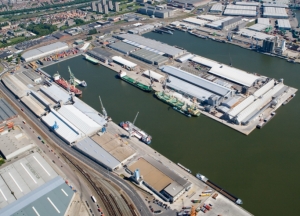


(Posted on 29/04/19)
Troughput of fertilisers at the Port of Antwerp has made a strong recovery in March, with the best monthly figures for the commodity since February 2011. This was despite overall volumes for bulk cargoes, including fertilizers being down for the full first quarter of 2019.
During the past quarter, the total maritime cargo turnover of Port of Antwerp fell by 3%, bringing the situation back to normal following the record figures of the first quarter in 2018. As the quarter unfolded, the total maritime cargo turnover again showed an upward trend. This trend is expected to continue in the coming months.
Total dry bulk transhipment decreased in the period by 8.8% as a result of the lower troughput of ore (-22.9%), coal (-16.5%), scrap (-10.2%) and fertilisers (-2.2%). Troughput of sand and gravel was up 6%. Troughput of fertilisers made a strong recovery in March, with the best month troughput since February 2011.
Dry bulk is traditionally characterised by high volatility, with various commodities having highly varying characteristics.
Conventional breakbulk did well in the first quarter of 2019, but moderately well compared to the exceptional first quarter of 2018, driven by the build-up of steel stocks in anticipation of US import levies. As a result, iron and steel transhipment remained 5% below last year’s level.
RoRo transhipment was up 3.2%. Despite the decline in the number of rolling stock units, the number of tonnes went up thanks to the average weight per vehicle, especially in the utility vehicle category.
Container traffic continues to grow, with March 2019 as the strongest month ever in terms of containers.
Liquid bulk recorded a decline of 8.6% in the first quarter. After two weaker months (-12.4%), March showed a marked recovery, albeit less pronounced for petroleum derivatives, the largest segment within liquid bulk. A mild winter in 2019 versus a colder one in 2019 has an impact on the transhipment of petroleum derivatives. Also the slowdown in growth of the EU economy had implications for production volumes and energy demand, as did the evolution of crude oil prices.
Of particular note was the recovery in the transhipment of petroleum and chemicals. After three months, crude oil transhipment remains unchanged with 0.1%. Chemicals remain virtually unchanged (-0.6%) and saw a nice recovery in March following a sharp decrease in January and February.
During the past three months, 3,519 seagoing vessels (-0.3%) called at Antwerp. The gross tonnage of these ships decreased by 0.2% to 101,539, 585 GT.
Annnick De Ridder, alderman for the Port, concluded: These figures confirm the role of Port of Antwerp as one of the main economic pillars of the country and as a major employer. To secure the future prosperity of our port, we urge Flanders to proceed soon with the approval of the draft preference decision on container handling capacity.”
Euroports has announced the renewal of the concession for Terminal Rinfuse Venezia (TRV) at Porto Marghera... Read more
Contributing to the commitment of achieving net zero emissions by 2050, the Panama Canal authority has... Read more
The Saguenay Port Authority in Quebec has ordered a Konecranes Gottwald ESP.6B Mobile Harbor Crane for... Read more
North Sea Port Supervisory Body has appointed Cas König as the port authority's new CEO. Kö... Read more
After 19 years at the helm of the Port of Trois-Rivières and a career rich in major projects,... Read more
Abu Dhabi based AD Ports Group, an enabler of integrated trade, transport and logistics solutions, has... Read more
The Port of Rotterdam and Port of Antwerp-Bruges have welcomed the Clean Industrial Deal, through which... Read more
The Canadian Port of Trois-Rivières is delighted to have received major funding of $87.1 million... Read more
Belgian logistics giant Katoen Natie has ordered four all-electric Konecranes Gottwald Mobile Harbor... Read more
AD Ports Group, Abu Dhabi based enabler of integrated trade, transport and logistics solutions, has... Read more